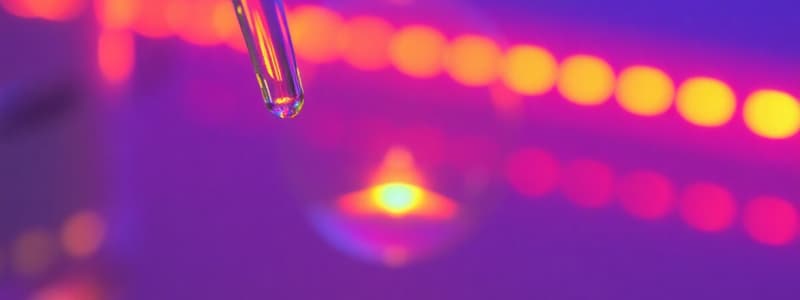Podcast
Questions and Answers
What is the primary function of a monochromator in an optical setup?
What is the primary function of a monochromator in an optical setup?
- To produce white light for experiments
- To amplify electrical signals
- To separate white light into specific wavelengths (correct)
- To store solutions used in experiments
Why is it important to handle cuvettes by the frosted or ridged sides?
Why is it important to handle cuvettes by the frosted or ridged sides?
- To ensure consistent light measurement
- To facilitate easier insertion into the sample chamber
- To prevent contamination from fingerprints (correct)
- To avoid breaking the cuvette
What does the detector measure during the Fe-SCN experiment?
What does the detector measure during the Fe-SCN experiment?
- The pressure inside the sample chamber
- The temperature of the sample
- The amount of light passing through the sample (correct)
- The color of the solution
What is the purpose of blanking the instrument with a reference solution?
What is the purpose of blanking the instrument with a reference solution?
After passing through the sample, how is the light energy processed for absorbance readings?
After passing through the sample, how is the light energy processed for absorbance readings?
Flashcards
Monochromator
Monochromator
A device that separates white light into its individual wavelengths.
Cuvette
Cuvette
A special container that holds the sample we're measuring. It's usually made of transparent material like glass or quartz.
Detector
Detector
The component of a spectrophotometer that measures how much light passes through the sample. It converts light energy into an electrical signal.
Sample Chamber
Sample Chamber
Signup and view all the flashcards
Blanking the instrument
Blanking the instrument
Signup and view all the flashcards
Study Notes
Light Source
- Produces white light, containing all wavelengths.
- Usually a tungsten or halogen lamp for visible light.
Monochromator
- Separates white light into specific wavelengths.
- Acts like a prism, splitting light into a rainbow.
- Selects the 590 nm wavelength for the Fe-SCN experiment.
Sample Chamber
- Holds the cuvette, a special transparent container.
- Contains the FeSCN²⁺ solution.
- Cuvettes should be handled by the frosted/ridged sides to avoid fingerprints.
Detector
- Measures how much light passes through the sample.
- Compares light transmission through the sample to a blank solution.
- Converts light energy into an electrical signal.
Computer/Display
- Converts the electrical signal into absorbance readings.
- Shows the numerical absorbance value for calculations.
- Requires a blank solution calibration (usually distilled water) to read zero absorbance.
- Measures how much light passes through the sample compared to the blank.
- Provides absorbance values for calculating concentrations.
Studying That Suits You
Use AI to generate personalized quizzes and flashcards to suit your learning preferences.



